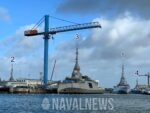Japan is accelerating its standoff strike capabilities by expanding deployment of the domestically developed Type 12 cruise missile across its naval platforms. The move includes integration onto surface combatants and submarines by fiscal years 2027–2028, reflecting Tokyo’s shift toward a more proactive deterrence posture amid growing regional threats.
From Truck to Sea: Evolution of the Type 12 Missile
The original Type 12 Surface-to-Ship Missile (SSM) was introduced in 2014 as a truck-launched coastal defense system developed by Mitsubishi Heavy Industries (MHI) for the Japan Ground Self-Defense Force (JGSDF). It featured inertial and GPS guidance with mid-course updates via data link, offering a range of approximately 200 km. Designed primarily for anti-ship roles in Japan’s littoral zones, it replaced the older Type 88 SSM.
Recognizing the need for longer-range precision strike capabilities against both naval and land targets in contested environments—particularly around the Nansei Islands—Japan initiated an upgrade program around FY2020. The enhanced version of the missile is often referred to as the “Extended Range” or “Improved” Type 12 (改良型), with reported range increases up to 900–1,000 km depending on platform configuration. This places it in a similar class to Western standoff weapons like the U.S. Navy’s Tomahawk Block IV or Norway’s NSM when deployed from ships or submarines.
Naval Integration Timeline and Platforms
The Japanese Ministry of Defense (MoD) confirmed that surface ship deployment of the upgraded Type 12 will begin in fiscal year (FY) 2026 (April 2026–March 2027), with submarine-launched variants following in FY2027. This aligns with Japan’s broader acquisition strategy under its National Defense Strategy (NDS) released in December 2022, which prioritizes counterstrike capabilities against enemy missile launchers and command nodes.
While specific platforms have not been officially disclosed, likely candidates include:
- Surface Combatants: Maya-class Aegis destroyers (DDG), Asahi-class destroyers (DD), and future Mogami-class frigates (FFM).
- Submarines: Sōryū-class and Taigei-class diesel-electric attack submarines equipped with vertical launch systems or capable torpedo tubes.
The integration will require modifications to vertical launch systems (VLS) or adaptation for torpedo-tube launch on submarines. The MoD has allocated funding for R&D into these adaptations since FY2021.
Operational Implications for Japan’s Deterrence Posture
The shift from purely defensive missile systems toward long-range strike options marks a significant doctrinal evolution for Japan’s Self-Defense Forces. Under Article 9 of its pacifist constitution, Japan traditionally avoided offensive capability development. However, growing concerns over North Korean missile threats and Chinese naval assertiveness—especially around Taiwan and the Senkaku/Diaoyu Islands—have prompted Tokyo to reinterpret its defense posture within a “counterstrike” framework.
The extended-range Type 12 provides Japan with several operational advantages:
- Stand-off Engagement: Enables engagement of enemy ships or shore-based missile batteries from outside their effective range.
- Multi-Domain Flexibility: Deployable from ground vehicles, ships, aircraft (planned), and submarines.
- Precision Strike: Incorporates terrain-contour matching guidance upgrades for improved accuracy against land targets.
This diversification enhances survivability during conflict while complicating adversary targeting calculus—a key goal under Japan’s new “integrated deterrence” approach aligned with U.S. Indo-Pacific strategy.
Mitsubishi Heavy Industries’ Role and Industrial Base Expansion
Mitsubishi Heavy Industries remains prime contractor for all variants of the Type 12 family. In FY2023 alone, Tokyo allocated over ¥211 billion (~$1.5 billion USD) toward mass production of upgraded missiles across multiple domains—including ship-, air-, ground-, and submarine-launched versions—under its “standoff defense capability” initiative.
The company is also working on a next-generation hypersonic glide vehicle under separate programs such as HVGP (Hyper Velocity Gliding Projectile), but near-term deterrence relies heavily on rapid fielding of mature cruise missile technologies like the Type 12 ER variant.
This investment supports not only operational readiness but also bolsters Japan’s domestic defense industrial base at a time when supply chain resilience has become a strategic imperative globally.
Regional Reactions and Strategic Context
The expanded deployment of long-range cruise missiles has drawn criticism from China and North Korea. Beijing views such moves as destabilizing steps toward Japanese remilitarization; Pyongyang routinely accuses Tokyo of preparing for preemptive strikes despite Japanese officials framing these developments strictly within self-defense parameters under international law.
However, Japan’s actions are broadly supported by regional partners including Australia, South Korea (with caveats), and especially the United States—which has encouraged allies to develop complementary strike capabilities under frameworks such as AUKUS Pillar II or Quad security dialogues.
This trend mirrors developments elsewhere in Asia-Pacific: South Korea fields submarine-launched Hyunmoo-3C cruise missiles; Taiwan is deploying Hsiung Feng IIE; Australia is co-developing LRASM derivatives through AUKUS-related programs. In this context, Japan’s expanded use of sea-based standoff weapons is part of a wider regional shift toward layered deterrence through distributed precision fires at extended ranges.
Conclusion: Toward Multi-Domain Standoff Capability
The integration of extended-range Type 12 cruise missiles onto Japanese warships and submarines marks a pivotal step in Tokyo’s transition from passive defense toward proactive deterrence within an increasingly contested Indo-Pacific environment. With deployments expected between FY2026–28 across multiple platforms—including future air-launched variants—the program underscores Japan’s commitment to fielding credible counterstrike options while maintaining alliance interoperability with U.S. forces.
If successfully integrated across domains without delays or cost overruns—a challenge given VLS constraints on legacy platforms—the upgraded Type 12 could become one of Asia’s most versatile indigenous standoff weapons over this decade.










